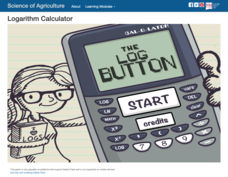Learning Games Lab
Controlling Water Activity in Food
Food storage matters! Scholars learn how the amount of water in corn can affect its rate of spoilage. They create a control group, then test three corn samples stored in three different locations for water activity. As a result of the...
Learning Games Lab
How to Use Oil Immersion Microscope
Teach the class how to use a microscope to identify bacteria in food. Scholars explore the different parts of the microscope and learn how to determine total magnification. They walk step-by-step through the procedure of preparing slides...
Learning Games Lab
The pH Scale and Meter Calibration
What are the different ways to test for pH? First, scholars explore the pH scale and a common way to test for acidity and alkalinity. Then, they learn about the importance of pH in food safety and why variance in pH could potentially...
Learning Games Lab
Testing and Adjusting pH
Pupils learn how to control food spoilage by adjusting the food's pH. They see that one of the most dangerous bacteria can grow in food if people don't handle and store food properly. Using knowledge of the bacteria's preferred pH,...
Learning Games Lab
Nitrogen in Fertilizer
Nitrogen is an essential element for productive farming. An interactive lesson explores the chemical makeup of different fertilizers and their corresponding nitrogen content. The interactive challenges individuals to complete molecular...
Learning Games Lab
Nitrogen in Pollutants
Responsible farming is important for maintaining natural resources. Eager scientists complete a WebQuest to explore what happens to nitrogen when it enters the soil. They learn about the chemical makeup of nitrogen-based molecules and...
Learning Games Lab
Scientific Graph Reading
Interpreting graphs is an essential skill for young scientists. An interactive online lesson gives individuals an opportunity to review the components of a graph and learn to read and interpret the shape of a graph. The lesson includes...
Learning Games Lab
The Magic of Reading Graphs
Making conclusions from graphs doesn't need to seem like magic. Learners explore an interactive lesson on reading graphs to strengthen their skills. The content discusses how to read the axes of a graph and draw conclusions based on the...
Learning Games Lab
Logarithm Calculator
Support your young scientists' knowledge of logarithms with a quick video lesson. The instruction first presents the relationship between a base-10 logarithm and an exponential equation. It then demonstrates how to use a calculator to...
Curated OER
Communication: Saying No
Students read about psychology by identifying uncomfortable teenage situations. In this sexual awareness lesson, students read assigned text which discusses the importance of saying "no" when you are in a hostile or uncomfortable...
Curated OER
7 Steps for Creating a Socially Conscious Community
Twelfth graders examine the steps that one can take to turn awareness of a human rights abuse into action it. In this Current events lesson, 12th graders analyze the compelling factors which can influence personal action in any given...
Curated OER
Human Rights & Equal Opportunity Commission
Students consider what human rights are. They comprehend the origins of modern human rights. Students appreciate the meaning and significance of the Universal Declaration of Human Rights. They appreciate the relationship between...
Curated OER
Where Should It Go? Recycle? Compost? Incinerate? Landfill?
Students discuss what happens to trash after it is collected. They sort "clean" trash into groups depending on whether it should be recycled, incinerated, placed in a landfill, composted or if it is something we could avoid using.
Curated OER
Multiply by Two-Digit Numbers
For this multiplication worksheet, students solve 13 problems in which dollars and cents or 3 digit numbers are multiplied by 2 digits. Students will need to rewrite some of the problems.
Curated OER
Left Foot, Right Foot
Students listen to "The Foot Book", by Dr. Seuss. They participate in a discussion/activity about the book and feet. They trace their feet, label them 'left foot' and 'right foot' and compare their drawings to one another.
Curated OER
In the Right Mode
Sixth graders practice determining mean, median, mode, and range using individual mileage logs. They convert miles to kilometers and graph their results.
Curated OER
'My Town' Brochure
Seventh graders use the Internet to research their town's history. They create a travel brochure for their town.
Curated OER
Building a Pyramid
Fifth graders, in groups, research and create a poster or brochure examining the new food pyramid. They create a one-day menu that satisfies the requirements.
Curated OER
I Wash My Hands of It!
Students conduct a survey about hand washing. They view the results and examine "Infection Charts". They research diseases and talk about the importance of handwashing and how they could improve their hand washing habits.
Curated OER
Texas, Our Texas
Students explore U.S. geography by completing a coloring activity in class. For this Texas history lesson, students utilize the web to locate Texas on a map of the U.S. Students view a PowerPoint presentation which showcases the state...
Curated OER
An Ounce of Prevention...
Students discuss current H.I.V. prevention strategies and adapt these strategies to address the spread of H.I.V. in developing countries. They analyze the results of an international AIDS conference called "The Urgent Search for an AIDS...
Curated OER
What is a Family?
Students explore how Canadian families have evolved over time. In this census results lesson, students examine the factors that contribute to changing family and household structures. Students also create written and illustrated profiles...
Curated OER
Meeting the Needs of an Aging Population
Learners examine population trends and predict how the age of the majority of Canadians will change 15 years from now in various geographic areas. They will gather statistical evidence that supports their projection. Learners will then...
Curated OER
Healthy People 2010
Ninth graders log on to the attached website. They use the "Online Slide Show" and think about the questions in the guide. They complete the slide show and guide, then and share their suggestions with the class.

























